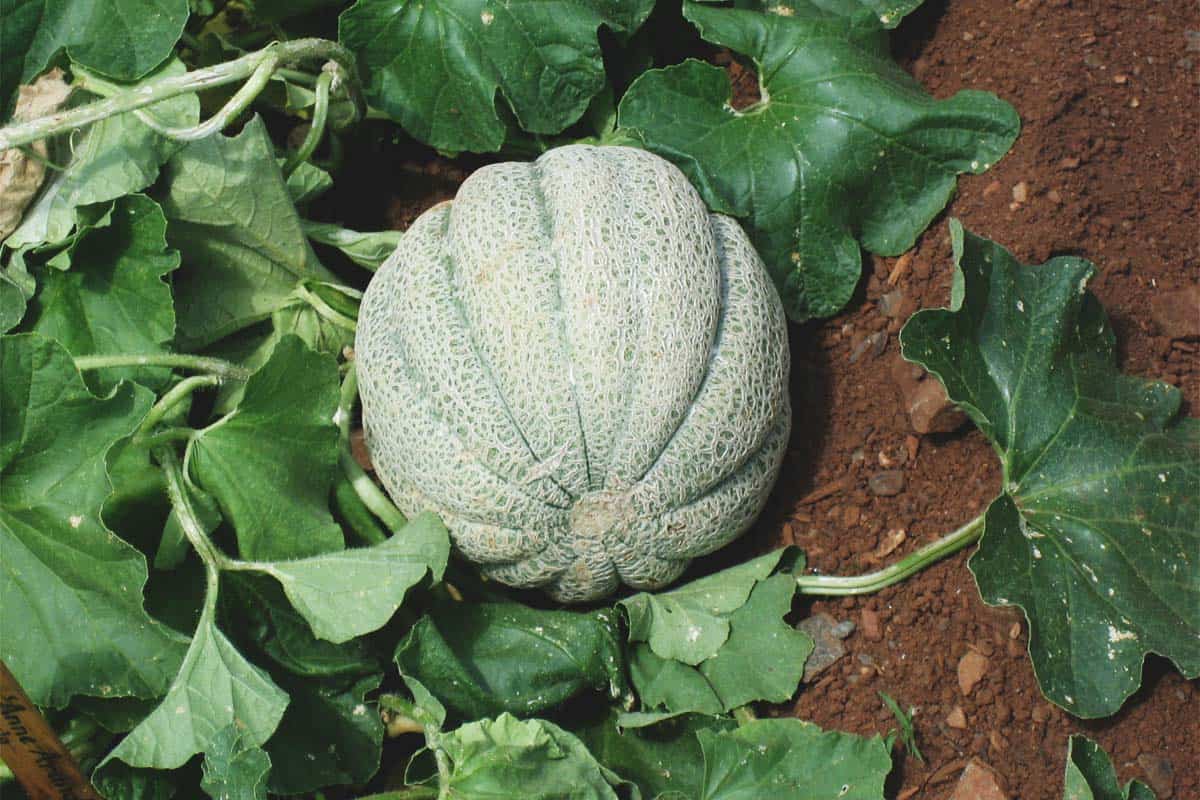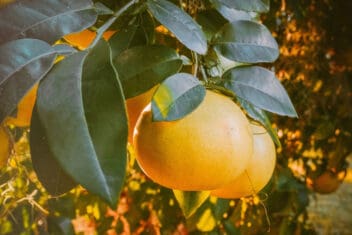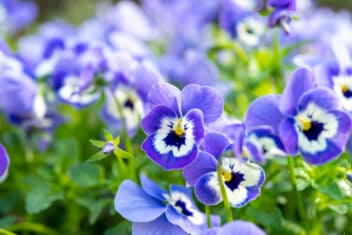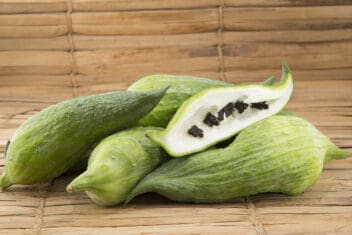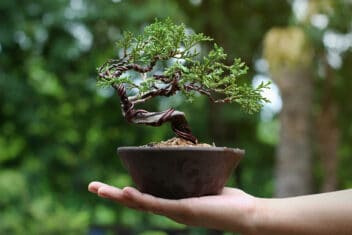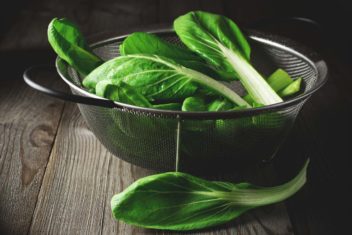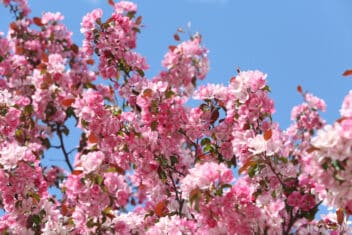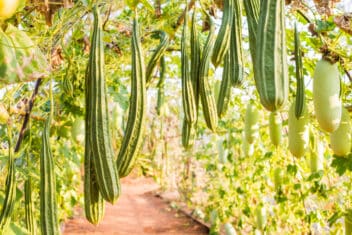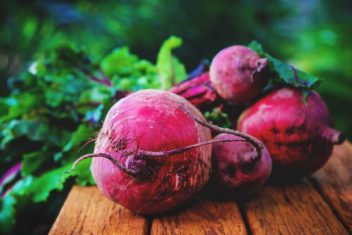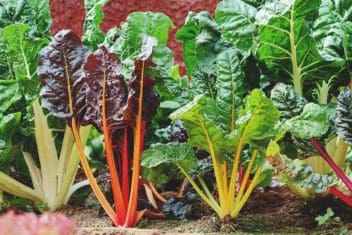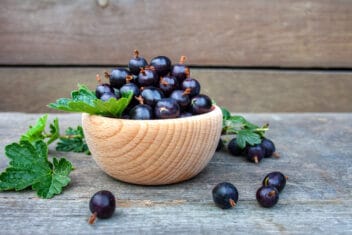Muskmelons are round, sweet fruits known for their sweet, enticing flavor and scent. If you’ve ever bought one at a farmer’s market, then you know melons at the grocery store are nothing compared to the muskmelons growing in your own garden.
Store-bought muskmelons are usually bland and hard, while garden-grown ones are soft, fragrant, and incredibly flavorful.
You probably know muskmelons as cantaloupes, but technically, that’s not right. Don’t worry, by the end of this article, you’ll know everything you need to know about these tasty melons.
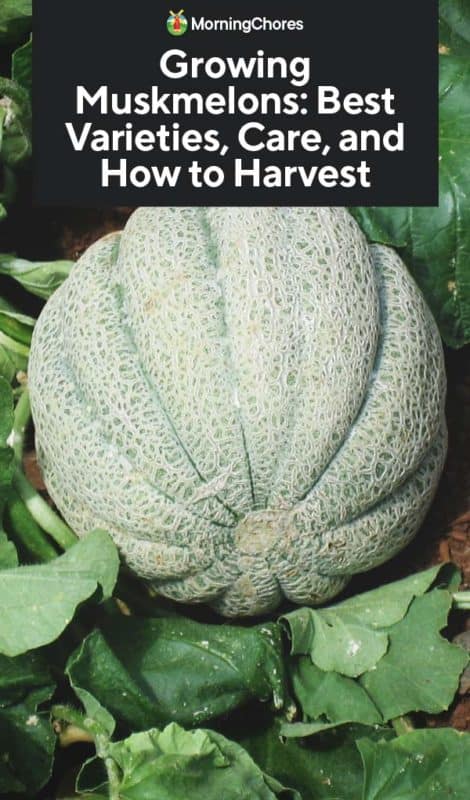
It’s All In The Family
The terms muskmelon and cantaloupe are often used interchangeably even by seed catalogs. However, if you’re picky about terms…
Both melons are part of the Cucurbitaceae family. All cantaloupes are muskmelons, but not all muskmelons are cantaloupes. Confused?
Cantaloupes are actually a type of muskmelon (so are honeydew and canary melons). What you buy in the store is usually what is known as the American cantaloupe, Cucumis melo reticulatus.
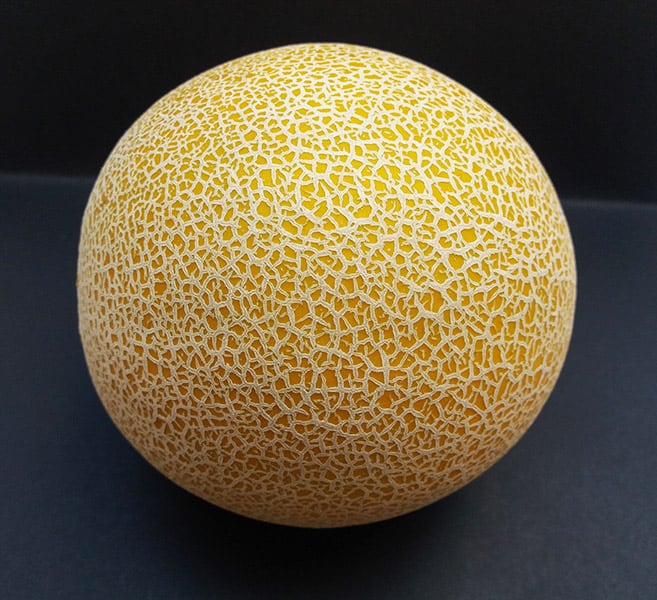
The traditional American cantaloupe has netted looking skin and deep orange-colored flesh. They are popular sliced for breakfast and for dessert served with some ice cream.
A true cantaloupe is known as a European cantaloupe, Cucumis melo cantalupensis.
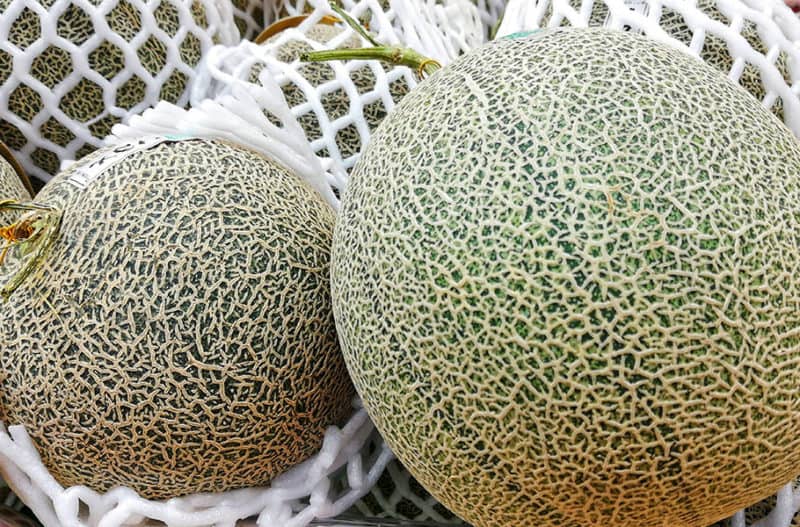
Regardless of what they’re called, they are planted, grown, and harvested in the same way.
Best Varieties
There are two types of muskmelons that you can try growing. Eastern muskmelons have deep ribs on the skin. The western varieties have smooth-skins.
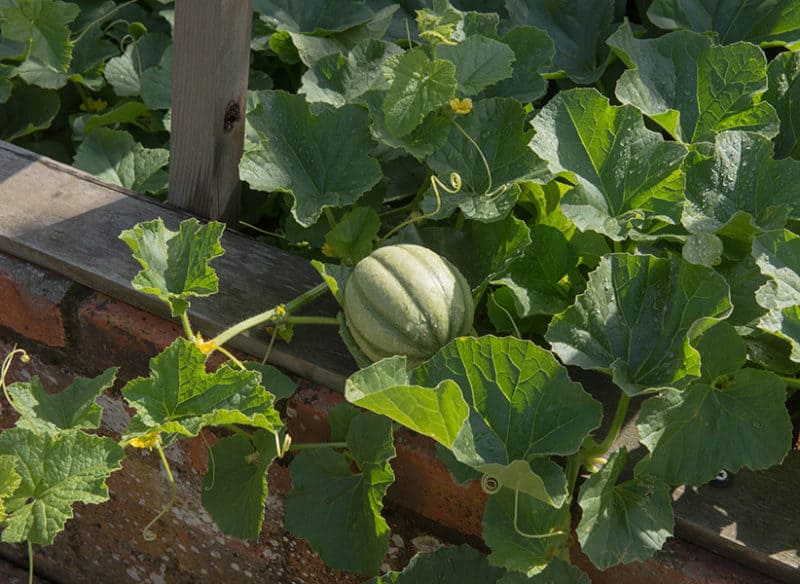
Some varieties are hybrids between different types of muskmelons.
Muskmelons don’t tolerate cold yet have a long growing season. It’s important to look at the maturity dates when choosing a variety. Make sure you have a long enough season.
Edens Gem
Eden’s Gem s a popular heirloom variety that has green instead of orange flesh. It’s a smaller melon averaging two and a half pounds. Ready to eat in 75 days.
Sarah’s Choice
We love melons at my house and this is one of my personal favorites. They have a super creamy sweet flavor that melts in your mouth and smells so good.
Sarah’s Choice has good disease resistance to fusarium wilt and powdery mildew. They grow to about three pounds in 76 days. They’re a hybrid.
Hannah’s Choice
This is another hybrid and has a rich sweet taste with a high Brix sugar rating of 13. It’s resistant to several Fusarium wilt races, powdery mildew, watermelon, and zucchini mosaic virus.
It does well in cooler regions of the country and will even grow in zone 4 with row covers during cold weather. Hannah’s Choice is extremely productive, producing three to five-pound fruits in 75 days.
Prescott Fond Blanc Melon
This heirloom melon is downright ugly with its warty, thick skin and flattened shape. Don’t let looks deceive you – it’s delicious and gets to be a hefty seven pounds. A true cantaloupe, Prescott Fond Blanc hails from France and has been grown there since the 1860s.
Resistant to wilts and has good yields with an average of four fruits per plant. It has a long growing season and needs 90 days till maturity.
Delicious 51
Another heirloom variety, Delicious 51 also does well in cooler climates. This is another of my favorite muskmelons for growing because it’s reliable. It’s not prone to powdery mildew, which is a problem in my humid climate.
The melons have deep orange flesh and a sweet flavor. In Kentucky, we often refer to these as “Indiana Melons.” I’m not sure why although Indiana grows a lot of melons!
Marygold
This casaba-type melon has fragrant, white flesh and yellow wrinkled skin. It matures in 90 days.
Honeyshaw
Honeyshaw is another casaba-type melon with delicious, salmon-pink flesh. It matures in 85 days.
Pulsar
This orange-fleshed melon is resistant to fusarium and powdery mildew, so it’s a good option if you struggle with those diseases. Matures in 80 days.
Planting Muskmelons
Melons love the sun and need warm weather to grow. Don’t set out seeds till about two weeks after your last frost.
Plant in rich well-draining soil that has been well composted the year before. They like slightly alkaline soil with a pH of 7.0. If you have heavy soil, consider amending it with sand or using raised beds.
Start from seeds
Start muskmelons from seeds in 18-cell trays or two to three-inch pots. Melons can be picky about being transplanted. Some people like to plant in peat pots or other compostable planters since its easier on the seedling at transplanting time.
Don’t rush planting your muskmelons! Seed them about four weeks indoor before you plant outside. In my zone 6b, I plant them about mid-April.
Plant seeds about 1/4 inches deep in a light seedling mix. They like it warm to germinate and if you can get the temperature up to 80-90°F that’s perfect. Once they germinate, the temperature can be lowered to around 75°F.
Young plants have tender leaves so handle with care. Keep the seedlings moist and don’t let the soil dry out. Watering from the bottom is the preferred method.
Transplant
When the weather has warmed and the soil temperature has reached above 65°F then you can plant out your seedlings. Transplant them two feet apart in rows six feet wide.
Give them a week hardening off period by gradually moving them outside and giving them an extra hour of light a day, starting with one hour on the first day.
Handle the roots with care as melons don’t like their roots to get bruised.
Direct Seed
Muskmelons have large seeds and are easy to plant by hand or with a seeder. Direct seed once your soil temperature has risen to 70°F.
For traditional rows, sow seeds one half of an inch deep and 18 inches apart. Space rows 5-6 feet wide.
One popular way to seed melons is by using the hill method. Using a hoe or rake, draw up the soil into mounds that are about four inches high and a foot wide. This creates the loose, well-draining soil muskmelons appreciate.
Plant three seeds in each of your hills. After a few weeks, pull the two smallest seedlings and leave the largest.
Season Extension
Using row covers and landscaping fabric can greatly improve your melon crops especially in cooler climates.
Black landscaping fabric will help warm the soil and keep in moisture. Remember to roll up and store your landscaping fabric at the end of the season. Don’t leave it in your garden to degrade.
Floating row covers will protect your young seedlings from cool winds, light frost, and rain. Don’t let the fabric set on the plants. You need to remove row covers when plants start producing flowers so that pollinators can do their jobs.
Caring for Muskmelons
Now that you’ve got your muskmelons growing, it’s time to nurture them until they’re ready for harvest. Here’s how:
Watering
Melons need lots of water early in life when the plants are growing, flowering, and starting to form fruit. However, when the fruit begins to ripen you can hold off on the watering.
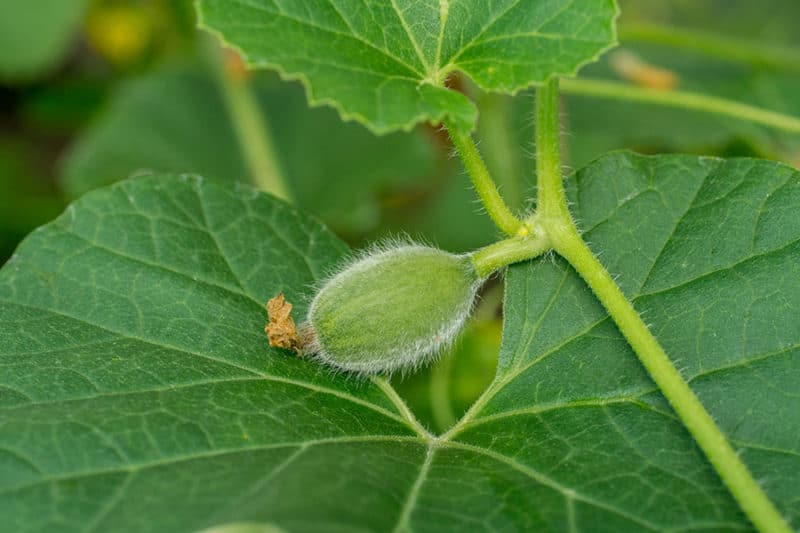
Too much water when they are ripening causes the sugars to dissipate. This makes the fruit bland. When you restrict the water the sugars concentrate making the muskmelons so much sweeter.
Fertilizer
Muskmelons are hungry plants while they’re growing. In addition to having rich healthy soil, you should fertilize. I prefer to use fish emulsion as a foliar feed.
Compost tea is also a great way to fertilize melons.
Problems and Solutions to Growing Muskmelons
Sadly, melons have quite a few problems. Don’t let that intimidate you. Not all issues show up every year. Keep an eye on your melons and check on them frequently.
Fungi
All melons are susceptible to many fungus’ and blights like fusarium and powdery mildew. While they love the hot steamy weather, those conditions can cause problems.
Make sure to give your melons plenty of space so they have good air circulation. Planting melons in landscaping fabric will help reduce diseases because it prevents the soil from splashing back up on the leaves.
You should also be sure to water at the base of plants and rotate your crops every two years. If you see this fungi on your plants, trim away any infected leaves and spray plants with neem oil.
Viruses and Bacteria
These plants are also attacked by several viruses, like mosaic and cucurbit stunting yellow virus. Also, watch out for bacterial issues like bacterial wilt.
Viruses and bacteria are spread by insects like aphids and cucumber beetles, so it’s important to keep these away from crops. Insecticides don’t work because in order for the chemical to work, the bugs need to land on and feed on plants, which means the disease can take hold.
Use trap crops, row covers, and reflective mulches, instead.
Cucumber Beetles
Cucumber beetles can harm plants as well as introduce bacterial wilt. Amaranth makes a good trap crop to draw the beetles away, or you can use yellow sticky traps.
Row covers help protect young plants and you can spray with pyrethrin or neem oil after you remove the covers. Clean up your garden in the fall to reduce cucumber beetles the next year.
Aphids
Aphids spread disease and can stunt plants. Our guide will show you how to spot and get rid of them.
Cutworms
Cutworms nibble the base of plants, cutting them off. Knowing how to spot and deal with them before they kill off your whole plant is vital.
Animal Thieves
Many species of wildlife love melons as much as you do. Raccoons, groundhogs, and deer can be particularly persistent. A good sturdy fence is your best option.
Field mice can also be a problem for growing muskmelons if you don’t have a good barn cat. Set melons on bricks to keep away from mice.
Companion Planting
Plant with corn, chamomile, savory, tansy, and nasturtium. Don’t plant with potatoes.
Harvesting and Using Muskmelon
Most melon varieties will slip off the vine when they are ripe with a small amount of pressure.
Use your nose. Ripe melons will smell sweet and delicious.
Storing
Muskmelons have a short shelf life of about two weeks. Store them at 85% relative humidity in a cool room or refrigerator, optimally at 40°F.
You can freeze melon for later use. Use only fresh, firm-fleshed, just ripe melons.
Cut melons in half and remove seeds and the skin. You can cut the melons into cubes or roll them into a ball.
Pack into freezer containers leaving a headspace. You can use water or make a syrup using 1 3/4 cups of sugar to four cups of water.
You can also make a tasty jam out of melons. Like any other jam, you mix fruit with sugar and pectin. You can try this Salted Cantaloupe Jam.
Cooking
If you love to grill you should try putting on some muskmelon. The heat from the grill causes the sugar in the melon to caramelized. You end up with a unique and delicious treat.
Cut melons into two-inch wedges. Remove the seeds but leave the end intact. Place them on a hot grill with the flesh side down. Grill about three minutes on each side till you can smell them cooking.
It also goes great with grilled fish or chicken.
Seed Saving
Muskmelons will cross-pollinate with other melons and cucumbers. If you plan to save seed from melons you need to separate them by 600 feet. You can time your plantings so that different species are flowering and being pollinated at different times.
Melon seeds last 3-5 years when properly stored.
Muskmelons can be a bit temperamental but they are well worth growing. A cool fresh cantaloupe is a joy to eat on a summer morning.
